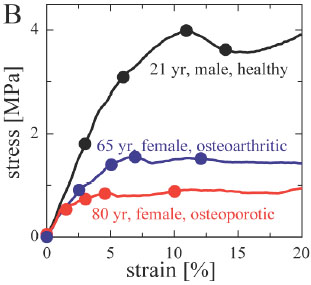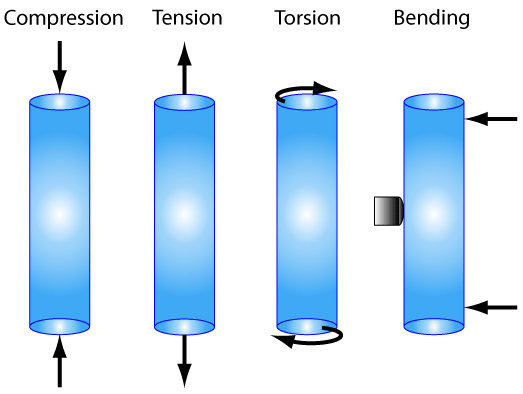class: center, middle, inverse, title-slide .title[ # Lecture 6 ] .subtitle[ ## Coarse Materials I ] .author[ ### Dr. Christopher Kenaley ] .institute[ ### Boston College ] .date[ ### 2025/30/1 ] --- class: inverse, top # Joints, Levers, and Linkages <!-- Add icon library --> <link rel="stylesheet" href="https://cdnjs.cloudflare.com/ajax/libs/font-awesome/5.14.0/css/all.min.css"> .pull-left[ Today we'll .... - Wrap up with muscls - What is stress, strain? - Define stiffness and other material properties - Start MP2 ] .pull-right[  ] --- class: top # Muscles generate mechanical work and power. ## How? .center[ <img src="img/sarcomere.jpg" width="400" /> ] --- class: top # Muscles generate mechanical work and power. ## How? .center[ <img src="img/filamenttheory.png" width="350" /> ] .footnote[ Sliding filament (crossbridge) theory. Gordon, Huxley & Julian (1966)] --- class: top # What determines amount of force produced by muscle? .pull-left[ 1. Time after activation ] .pull-right[ <img src="img/latent.jpg" width="450" /> ] --- class: top # What determines amount of force produced by muscle? .pull-left[ 1. Time after activation 2. Muscle (sarcomere) length <br> <br> <img src="img/filiments.jpg" width="550" /> ] .pull-right[ <br> <br> <br> <br> <img src="img/forcelength.png" width="550" /> ] --- class: top # What determines amount of force produced by muscle? .pull-left[ 1. Time after activation 2. Muscle (sarcomere) length 3. Shortening velocity <br> <img src="img/forcevel.png" width="550" /> ] --- class: top # What determines amount of force produced by muscle? .pull-left[ 1. Time after activation 2. Muscle (sarcomere) length 3. Shortening velocity <br> <img src="img/forcevel.png" width="550" /> ] .pull-right[ V=? to maximize power? `$$P=F\times V$$` <br> <br> <img src="https://d3i71xaburhd42.cloudfront.net/2b0ce8ae4ce7e28430b71ba8983e33c3bad9c196/3-Figure2-1.png" width="550" /> ] --- class: top # What determines amount of force produced by muscle? .pull-left[ 1. Time after activation 2. Muscle (sarcomere) length 3. Shortening velocity <br> <img src="img/forcevel.png" width="550" /> ] .pull-right[ Formalize F-V relationship... the Hill equation: `$$\frac{T}{T_o}=T^\prime=\frac{1-\frac{v}{v_{max}}}{1+c\frac{v}{v_{max}}}=\frac{1-v^\prime}{1+cv^\prime}$$` <img src="https://d3i71xaburhd42.cloudfront.net/2b0ce8ae4ce7e28430b71ba8983e33c3bad9c196/3-Figure2-1.png" width="550" /> .footnote[ `\(c\approx 1.2-4\)` ] ] --- class: top # Metrics of muscle function ## Generate mechanical work and power .pull-left[ - Work = `\(F\cdot\Delta L\)` (Joules) - Power = Work/time (Joles/s = Watts) - Power = Work x Frequency (Joules/s = Watts) - Power = F x V (Joules/s = Watts) <br> ] .pull-right[ <br> <img src="img/musclework.png" width="250" /> .footnote[ ] ] --- class: top # Metrics of muscle function ## The work loop technique .pull-left[ - Work = `\(F\cdot\Delta L\)` (Joules) - Power = Work/time (Joles/s = Watts) - Power = Work x Frequency (Joules/s = Watts) - Power = F x V (Joules/s = Watts) .center[ <img src="img/muscletest.png" width="60" /> ] ] .pull-right[ <br> <img src="img/workloop.png" width="200" /> .footnote[ ] ] --- class: top # Metrics of muscle function .center[ <img src="img/motorbreakstrut.png" width="600" /> ] --- class: top # Lots more to study We know we don't know a lot about muscles .center[ <img src="https://s3-eu-west-1.amazonaws.com/s3-euw1-ap-pe-ws4-cws-documents.ri-prod/9780367190811/central/musclefuels/images/gastrocnemius.jpg" width="400" /> Doublet potentiation ] --- class: top # Lots more to study We know we don't know a lot about muscles .center[ <img src="https://journals.physiology.org/cms/10.1152/jappl.1997.82.4.1219/asset/images/large/japp0542801.jpeg" width="400" /> Doublet potentiation ] --- class: top # Lots more to study We know we don't know a lot about muscles .center[ <img src="https://www.researchgate.net/profile/Stanley-Salmons/publication/11155153/figure/fig5/AS:276867023163394@1443021650100/Mean-nFTIpP-n-6-for-doublets-lower-surface-triplets-intermediate-surface-and.png" width="400" /> ] --- class: top # Material and structures .pull-left[ - Loads and deformations -- basic concepts - Stress: the distribution of force over an area - Strain: a dimensionless measure of deformation - Stiffness: a measure of how materials respond to stress (or strain) - Loads: the relationship between stress and strain - Strength: the stress at breaking ] .pull-right[  ] --- class: top # Material and structures .pull-left[ - All (biological) materials respond to external forces by deforming - We seek a way to understand and characterize these responses - Material behavior as separate from structural behavior - We will formalize the relationships between force and deformation ] .pull-right[  ] --- class: top # Material properties ## Types of deformation .center[ ] .center[  ] --- class: top # Material properties ## Types of deformation .pull-left[ Stress: `$$\sigma=\frac{F}{A}$$` `\(Pa=N\cdot m^2\)` Strain `$$\varepsilon=\frac{L-L_o}{L_o}$$` Units? ] .pull-right[ <img src="img/loads.png" width="350" /> ] --- class: top # Material properties .pull-left[ `$$stress(\sigma)=\frac{F}{A}$$` <img src="img/strainarrows.png" width="350" /> Young's modulus: `\(E=\frac{\sigma}{\varepsilon}\)` What are units of `\(E\)`? ] .pull-right[ `\(strain(\varepsilon)=\frac{L-L_o}{L_o}\)` Hook's law: `\(F=K\Delta L\)` <img src="img/stressstrainstiff.png" width="350" /> ] --- class: top # Material properties .pull-left[ `\(\sigma\)`: distribution of force over and area `\(\varepsilon\)`: dimensionless measure of length of change stiffness (E): change in stress relative to strain (slope of stress-strain curve) <img src="img/tendoncurve.png" width="250" /> ] .pull-right[ Most biological materials are non-linearly elastic <img src="img/bonehaircurve.png" width="250" /> ] --- class: top # Material properties .pull-left[ `\(\sigma\)`: distribution of force over and area `\(\varepsilon\)`: dimensionless measure of length of change stiffness (E): change in stress relative to strain (slope of stress-strain curve) <img src="img/tendoncurve.png" width="250" /> ] .pull-right[ Most biological materials are non-linearly elastic <img src="img/failuretable.png" width="250" /> ] --- class: top # Material properties .pull-left[ `\(\sigma\)`: distribution of force over and area `\(\varepsilon\)`: dimensionless measure of length of change stiffness (E): change in stress relative to strain (slope of stress-strain curve) <img src="img/stressstraincurve.jpg" width="350" /> ] .pull-right[ Most biological materials are non-linearly elastic <img src="img/failuretable.png" width="250" /> ] --- class: center, middle # Thanks! Slides created via the R package [**xaringan**](https://github.com/yihui/xaringan).